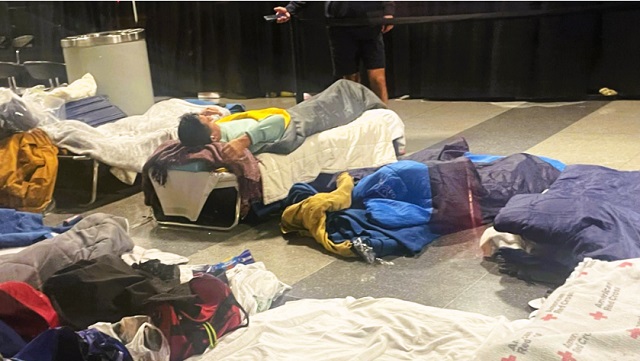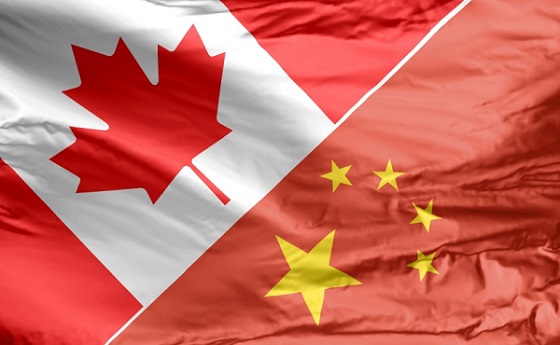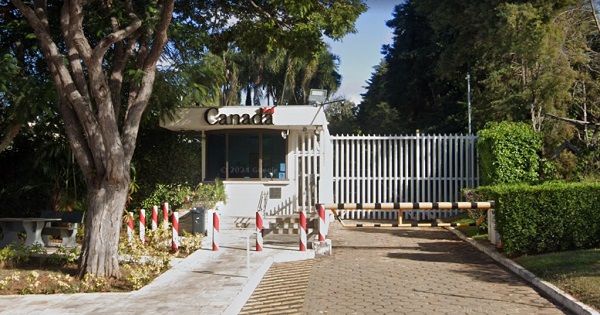Economy
‘What constitutes a border crisis?’ Sanctuary cities have found out

Migrants and migrant bedding inside O’Hare International Airport in Chicago.
From The Center Square
By Tom Gantert
Yeah, you liked them when it wasn’t your problem because you’re not a border state. And then when they show up in Chicago and New York, you’re like ‘What the [expletive] are we going to do with these people?’”
In March 2021, the Los Angeles Times published a story with a headline that asked, “What constitutes a border crisis?”
The story quoted then House Republican Leader Kevin McCarthy as saying, “There is no other way to claim it than a Biden border crisis.”
Then the LA Times asked, “But is it a crisis?”
Just a month later in April 2021, New York City Mayor Bill de Blasio released a statement about his city being a sanctuary city.
“New York City is proud to be a welcoming and inclusive city for immigrants,” de Blasio said at the time.
The debate in the U.S. on migrants took off in April 2022 when Texas Gov. Greg Abbott decided to take a stand against President Joe Biden and what Abbott called an open border policy.
Abbott stated that Biden’s repeal of Title 42 – a pandemic-era policy that allowed the government to quickly expel arriving asylum seekers – had created an “unprecedented surge of illegal aliens” into the country with as many as 18,000 apprehensions a day.
Abbott said that Texas border towns were being overrun by migrants and were overwhelmed. His solution was to bus many of the arriving migrants to sanctuary cities across the U.S.
In August 2022, when the first bus of migrants leaving Texas arrived in New York, Abbott was clear why he had his state paid for the trip. New York had a new mayor by then.
“New York City is the ideal destination for these migrants, who can receive the abundance of city services and housing that Mayor Eric Adams has boasted about within the sanctuary city,” Abbott stated in a news release. “I hope he follows through on his promise of welcoming all migrants with open arms so that our overrun and overwhelmed border towns can find relief.”
And just over a year later, New York Gov. Kathleen Hochul was on CNN in September 2023 pleading with immigrants to “go somewhere else.”
How it has played out was not lost on liberal comedian Bill Maher.
“Could everyone just stop the posturing?” Maher said on a July 2023 podcast with Sharon Osbourne. “Don’t pretend that you love migrants so much and then when we send them to you, you don’t like them. You know? You’re full of [expletive]. And we can see that. Yeah, you liked them when it wasn’t your problem because you’re not a border state. And then when they show up in Chicago and New York, you’re like ‘What the [expletive] are we going to do with these people?’”
New York wasn’t the only destination for Abbott’s buses. He also targeted other sanctuary cities, such as Washington, D.C, Chicago and Denver.
The New York Times published an article in July 2023 that had a headline that asked, “Is Texas’ Busing Responsible for the Migrant Crisis Across Cities?”
On June 14, Abbott’s office stated that it had bused 119,200 migrants to six sanctuary cities since August 2022. That included 45,700 migrants to New York City and 36,900 migrants to Chicago since August 2022. There were also 19,200 migrants bused to Denver since May 2023 and 12,500 migrants bused to Washington D.C. since April 2022.
But Abbott wasn’t alone in busing migrants from the border to locations throughout the country. The Democratic-run city of El Paso also bused migrants north.
Democratic Arizona Gov. Katie Hobbs stated in September 2023 that Arizona was “overwhelmed” by the flow of migrants into her state. Arizona spent $10.5 million transporting 10,247 migrants out of state as of September 2023.
That’s just part of a bigger surge of migrants into the U.S. Since Biden took office in January 2021, about 12 million illegal border crossings have been documented, according to U.S. Customs and Border Protection data and a compilation of “gotaway” data obtained from border agents by The Center Square. Gotaways is the official CBP term to describe those who illegally crossed the border between ports of entry but who were not apprehended. CBP does not publicly release “gotaway” data.
The increase in migrants has hammered the budgets of sanctuary cities.
Washington, D.C. created an Office of Migrant Services with an initial start-up cost of $10 million in 2022. In 2025, the city budgeted $39 million for that office.
Chicago has spent $299 million on migrants since 2022, according to a March 2024 report by the Illinois Policy Institute, and that does not include the hundreds of millions of dollars state taxpayers have paid for costs such as migrant health care.
New York City Mayor Adams said in August 2023 the migrant crisis may cost his city $12 billion over three years.
The city of Denver stated in April 2024 that the increase in migrants has cost it $63 million.
The cost to taxpayers in the state of Texas was $13.4 billion in 2023, according to the Federation For American Immigration Reform. Only California had a higher cost at $30.9 billion.
Ira Mehlman, spokesman for the Federation For American Immigration Reform, said Abbott’s busing strategy has worked.
“His busing policy exposed the hypocrisy of many sanctuary jurisdiction politicians who extolled the virtues of mass immigration regardless of its legality, but are not so happy when they actually have to deal with the real impact of large numbers of migrants,” Mehlman said in an email to The Center Square. “So long as it was someone else’s problem, they were happy to virtue signal and criticize others. Once it became their problem, they demanded that Abbott and others stop sending them migrants. For years, these sanctuary proponents claimed that illegal aliens were a benefit to the country, but are now demanding federal assistance to manage to cover their costs, exposing the fact that illegal immigration imposes huge fiscal costs.”
Tom Gantert
Managing Editor
Business
Trump’s Tariffs Have Not Caused Economy To Collapse


From the Daily Caller News Foundation
By Mark Simon
The APEC Summit in Korea last week marked a pivotal moment for U.S. trade policy, delivering tangible wins for American interests. Solid deals were struck with South Korea, while the U.S. and China de-escalated their long-simmering trade war—a clear positive for President Trump. In the chaotic world of Donald Trump, such normalcy disappointed the news media and foreign policy pundits, who grumbled that the event lacked the drama of a disaster.
Yet, as Trump departed Busan, a deeper transformation unfolded, largely overlooked by observers. In just two days, President Trump orchestrated the most significant shift in U.S. trade strategy since China’s 2001 entry into the World Trade Organization (WTO).
The real triumph? Widespread acceptance by Asian trading partners of U.S. tariffs as a cornerstone of a reimagined American economic model. This acceptance dismantles nearly a century of unwavering belief in low tariffs as the unassailable path to global prosperity.
Trump’s tariff approach disrupts the post-World War II global trading system, particularly the U.S.-championed free-trade orthodoxy embraced by both parties for over 50 years. By wielding tariffs effectively, Trump challenges the free-market gospel enshrined in the WTO and echoed by World Economic Forum elites and corporate-sponsored Washington think tanks like AEI and CATO, which decry tariffs as heresy.
At APEC, there was no fiery backlash—only quiet nods to moderate tariffs as fixtures in the evolving economic order. Leaders from across the Asia-Pacific assessed the tariffs’ impacts and moved forward without spectacle, signaling a pragmatic pivot toward Trump’s view of international commerce.
Historically, tariff reductions in Asia stemmed from U.S. pressure to open markets. Mercantilist instincts run deep in most Asian governments—except in freewheeling Hong Kong and Singapore. These nations, built on exports inside protected markets, grasp how tariffs can revitalize U.S. manufacturing and bolster federal revenue. Unlike America’s one-sided openness to Asian imports, Trump’s reciprocity feels like overdue fairness.
As a former free-market purist who once decried tariffs, I initially missed their nuance in Trump’s arsenal. Tariffs impose costs, but the genius lies in offsetting them strategically. Trump’s aggressive deregulation, sweeping tax reforms, and drive for rock-bottom domestic energy prices mitigate burdens and generate a net economic surge—one that Asian leaders implicitly endorsed.
This “internal free-market trio” forms the bedrock of the new U.S. paradigm: moderate tariffs generate revenue and incentivize factory repatriation; deregulation slashes red tape; tax cuts keep capital flowing competitively; and abundant, cheap energy undercuts foreign advantages.
Together, they magnetize global investment, upending a century of free-trade dogma. Energy dominance is key. Through promotion of domestic oil, gas, and renewables, Trump has driven U.S. energy costs 30–50% below those in Europe or much of Asia. For capital-intensive sectors like steel, semiconductors, and electric vehicles, this is structural superiority, not subsidy. Layer on the 2017 Tax Cuts and Jobs Act—slashing the corporate rate to 21% and allowing immediate capital expensing—and the math tilts toward U.S. production. Tariffs may raise import prices by 20–30%, but deregulation accelerates cost-cutting, while energy savings absorb part of the hit.
Critics claim tariffs ravaged the economy post-2018, but COVID-19, not tariffs, triggered the downturn. Trump’s initial round was a successful pilot, extended by Biden—yet without Trump’s deregulation and energy surge, the tariffs became un-offset weight. Blanket cost hikes under Biden stifled growth; Trump’s selective offsets ensure expansion.
America’s edge sharpens as rivals falter. Europe, shackled by leftist policies, environmental mandates, and the Ukraine quagmire, hemorrhages capital to the U.S. In North Asia—China, Korea, Japan, Taiwan—demographic headwinds make investments unappealing compared to North America’s burgeoning market. Aging populations and shrinking workforces amplify this disparity.
APEC underscored America as a vibrant, tariff-protected haven primed for onshoring. Amid Asia’s labor crunch, nations view the U.S. as an investment beacon, mirroring Japan’s model: a high-value exporter offloading low-end manufacturing while retaining competitiveness. Summit chatter revealed minimal tariff gripes. China voiced tepid concerns over escalations, but these seemed rhetorical—testing boundaries rather than igniting conflict.
To free-trade zealots, Trump’s heresy is demolishing sacred economic theory. Past protectionists erred by isolating tariffs without cost-lowering measures. Trump integrates them: selective duties paired with deregulation, technological leaps, and economic decentralization beyond urban centers.
In equilibrium, tariffs harvest revenue and reclaim jobs, capitalizing on America’s fiscal and regulatory advantages. Trump’s blueprint restores balance to free trade, honoring national sovereignty while exposing borderless markets’ perils. It proves moderated protectionism can ignite growth, spur innovation, and draw capital—heralding a bolder, self-reliant American century.
Mark Simon is former group director for Next Digital, parent company for Apple Daily, the leading pro-democracy newspaper in Hong Kong until it was forced to close in 2021.
Business
Carney government should retire misleading ‘G7’ talking point on economic growth

From the Fraser Institute
By Ben Eisen and Milagros Palacios
If you use the more appropriate measure for measuring economic wellbeing and living standards—growth in per-person GDP—the happy narrative about Canada’s performance simply falls apart.
Tuesday, Nov. 4, the Carney government will table its long-awaited first budget. Don’t be surprised if it mentions Canada’s economic performance relative to peer countries in the G7.
In the past, this talking point was frequently used by prime ministers Stephen Harper and Justin Trudeau and their senior cabinet officials. And it’s apparently survived the transition to the Carney government, as the finance minister earlier this year triumphantly tweeted that Canada’s economic growth was “among the strongest in the G7.”
But here’s the problem. Canada’s rate of economic growth relative to the rest of the G7 is almost completely irrelevant as an indicator of economic strength because it’s heavily influenced by Canada’s much faster rate of population growth. In other words, Canada’s faster pace of overall economic growth (measured by GDP) compared to most other developed countries has not been due to Canadians becoming more productive and generating more income for their families, but rather primarily because there are more people in Canada working and producing things.
In reality, if you use the more appropriate measure for measuring economic wellbeing and living standards—growth in per-person GDP—the happy narrative about Canada’s performance simply falls apart.
According to a recent study published by the Fraser Institute, if you simply look at total economic growth in the G7 in recent years (2020-24) without reference to population, Canada does indeed look good. Canada’s economy has had the second-most total economic growth in the G7 behind only the United States.
However, if you make a simple adjustment for differences in population change over this same time, a completely different picture emerges. Canada’s per-person GDP actually declined by 2 per cent from 2020 to 2024. This is the worst five-year decline since the Great Depression nearly a century ago. And on this much more important measure of wellbeing, Canada goes from second in the G7 to dead last.
Due to Canada’s rapid population growth in recent years, fuelled by record-high levels of immigration, aggregate GDP growth is quite simply a misleading economic indicator for comparing our performance to other countries that aren’t experiencing similar increases in the size of their labour markets. As such, it’s long past time for politicians to retire misleading talking points about Canada’s “strong” growth performance in the G7.
After making a simple adjustment to account for Canada’s rapidly growing population, it becomes clear that the government has nothing to brag about. In fact, Canada is a growth laggard and has been for a long time, with living standards that have actually declined appreciably over the last half-decade.
-

 Business2 days ago
Business2 days agoTrans Mountain executive says it’s time to fix the system, expand access, and think like a nation builder
-

 International2 days ago
International2 days agoBiden’s Autopen Orders declared “null and void”
-

 MAiD2 days ago
MAiD2 days agoStudy promotes liver transplants from Canadian euthanasia victims
-

 Business2 days ago
Business2 days agoCanada’s combative trade tactics are backfiring
-

 Business2 days ago
Business2 days agoCanada has given $109 million to Communist China for ‘sustainable development’ since 2015
-

 Business2 days ago
Business2 days agoYou Won’t Believe What Canada’s Embassy in Brazil Has Been Up To
-

 Crime1 day ago
Crime1 day agoPublic Execution of Anti-Cartel Mayor in Michoacán Prompts U.S. Offer to Intervene Against Cartels
-

 Automotive2 days ago
Automotive2 days agoCarney’s Budget Risks Another Costly EV Bet







